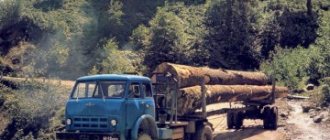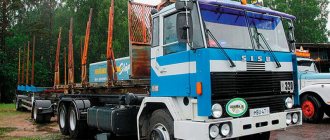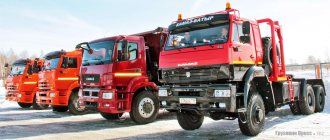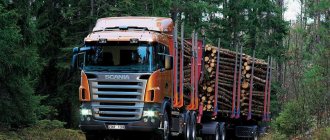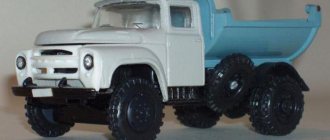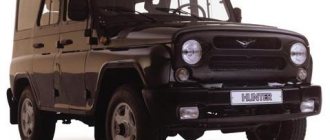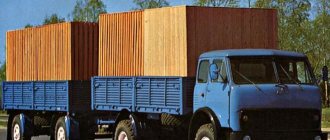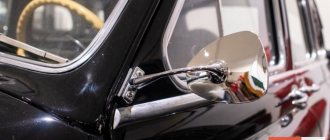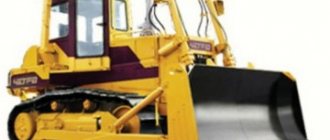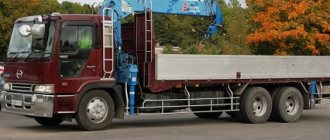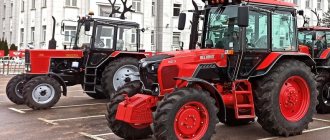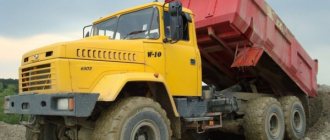As you know, any war sooner or later ends in peace. And therefore it is not surprising that the Soviet Union, which at one time defeated Nazi Germany, after the end of hostilities began to actively rebuild the destroyed state property. It goes without saying that any construction requires special equipment. In this regard, a special burden fell on the Minsk Automobile Plant, which began production of its own timber truck. We will talk about it in this article, and find out, in particular, how much the frame from the MAZ-509 weighs.
Updated vehicle fleet
Initially, the 500 series, to which this car belongs, was progressive and to some extent changed the consciousness of Soviet engineers and drivers. And all because the developers of the car proposed placing the engine directly under the cabin, and not in front of it, as was previously the case. Also, the cabin itself received the ability to tip over, which made it possible to easily reach the main components of the MAZ-509. In addition, the absence of a hood made it possible to increase the length of the entire truck and increase its carrying capacity. Initially, such an engineering proposal was met with hostility, but foreign experience showed that such machines are quite viable, and therefore the technical commission approved the project.
Car history
It is logical that the first MAZ-200 could not remain practical for long, and it was replaced in 1965 by the new MAZ-500 truck. The most noticeable difference was, of course, the redesigned body structure. The frame was located on the bridges in such a way that this increased the vehicle's carrying capacity, and at the same time its efficiency. And, since there was no longer a hood, since the engine was placed under the cab, the visibility for the driver increased.
In addition, as in the previous version, there are still three seats, including the driver's seat. Only the modification in the form of a dump truck had two seats. While working on the cabin of the new “silovik”, the designers took care of the driver and more comfortable and convenient control of the car. Controls such as the steering wheel, gearshift lever and instrument panel were located rationally. They didn’t forget about the colors of the upholstery, not counting the fact that there was any at all; the range consisted of pleasant colors in calm shades.
A convenient innovation was the presence of a sleeping place. For the first time for MAZ cars. It was the absence of a hood that allowed the “500th” model to become history. The fact is that such a design was put into operation for the first time in the Soviet automobile industry. In the 60s, the whole world began to carry out a similar revolution, since the hood significantly interfered with the control of a large vehicle.
But, given the need to raise the country after the war, the quality of roads suitable for the use of cabover cabs became suitable only twenty years later. And then in 1965 the MAZ-500 appeared, which became a worthy replacement for its previous model “200”. The truck remained on the assembly line until 1977.
The basic configuration was already a hydraulic dump truck, but the platform still remained wooden, although the cabin was already made of metal. The development focus, of course, was on versatility. Achieving this goal made it possible to use the machine in all possible areas where transportation was required.
It was enough to simply develop a modification with the required module on board. This model had the ability to start from a tractor. This meant that electricity was not required to start the engine when necessary. This feature was very useful for military needs.
This is interesting: What is a mulcher and where is it used?
Worthy change
The gradual technical modernization of the car led to the fact that it was able to drive faster. The truck's speed increased from 60 km/h to 65 km/h, which was made possible by changing the gear ratios of the gearbox. The MAZ-509 differed from its progenitor in that it had a wider wheelbase, the size of which immediately increased by 10 centimeters. A double-disc clutch also appeared, and the load capacity increased (by half a ton). The front axle also underwent changes: conventional gearboxes were installed on it instead of planetary gearboxes.
Modifications
The Minsk Automobile Plant produced several versions of the timber truck:
- An early option is the 509P model, which was supplied to customers for only 3 years (since 1966). The machine used a front drive axle with planetary gearboxes installed in the hub. The transmission uses a dry clutch with 1 working disc.
- In 1969, a modernized car model 509 entered the production line. The car was distinguished by a modified clutch circuit, changed gear ratios in the transfer gearbox and gearbox. To simplify the design, spur gearboxes began to be used in the front axle. Design improvements made it possible to increase the load capacity by 500 kg.
- Since 1978, production of the MAZ-509A began, which received modifications similar to the basic version of the truck. For unknown reasons, the car was not given a new designation. An external change was the relocation of the headlights to the front bumper. The cab has a new decorative grille with combined lamps on plugs installed in place of the holes for the headlights. The brake drive received a separate drive circuit across the bridges.
Purpose
The MAZ-509, whose frame was characterized by increased rigidity, was developed and served for the transportation of timber both on special roads and on shield tracks. At the same time, he had the opportunity to enter forestry. To ensure optimal loading/unloading conditions, since 1969, the machine began to be equipped with a winch with a rotating horse and folding racks. The horseman was able to withstand a load of 5500 kgf. The truck was equipped with a trailer-dissolution: TMZ-803M or GBK-9383. These mechanisms had two axles and a self-pulling device, which made it possible, if necessary, to fold the trailer trolley and load it onto the tractor. In those moments when the cart was not in use and was loaded onto a tractor, the MAZ became two-axle. When the need arose to transport wood, the trailer was folded out and the truck was transformed into a four-axle one, with both axles being drive axles.
Timber carrier MAZ-509
MAZ-509 was a tractor equipped with a trailer. Timber trucks based on the 500 series of MAZ trucks were produced for a very long time; during production it was modernized twice. The production of MAZ timber trucks began in 1966 with the MAZ-509P model.
MAZ-509P was a trial series with not a very large number of cars produced. Production of this version did not last long - until 1969.
Immediately after the start of production of the MAZ-509P model, the plant’s designers began searching for and eliminating shortcomings in this car. The result of this was the almost parallel production of a slightly improved model - MAZ-509. The production of this model was longer - its mass production began in 1966 and ended in 1978.
The MAZ-509 model was replaced in 1978 by a timber carrier with the designation MAZ-509A. This was the last timber carrier built on the basis of the 500 series of MAZ trucks. The MAZ-509A model was produced until 1990. Photo of timber truck MAZ-509
Specifications
The timber carrier is based on a riveted frame made up of stamped elements. The axles have dependent leaf spring suspension and double-acting hydraulic shock absorbers are installed at the front. The power unit is a 180-horsepower naturally-aspirated diesel engine YaMZ-236. The engine has 6 cylinders arranged in a V-shape. A mechanical high-pressure pump equipped with a centrifugal speed controller is used to supply fuel.
The engine has a forced liquid cooling system. By separate order, a liquid pre-heater was installed on timber carriers. The device simplified engine starting at ambient temperatures from -40°C. The fuel supply is located in 2 tanks, each holding 175 liters of liquid.
The gearbox has 5 forward speeds. Additionally, a transfer gearbox is used to distribute torque between the axles. The design of the unit has a center differential that increases cross-country ability. Between the transfer case and the axle housings, cardan shafts with splined connections are installed. The rear axle has twin wheels. The tires have a standard road pattern, but there were versions of the car with all-terrain tires.
The brake system of the car is drum type with pneumatic drive. The source of compressed air is a compressor installed on the power unit. The truck uses 24V electrical equipment. The steering is equipped with a hydraulic booster.
Design features
These trucks are designed as tractors with a long frame and a body for transporting timber, have excellent cross-country ability, as they are equipped with a short wheelbase, and can also transport cargo over long distances.
The equipment is equipped with a rotating device and a special trailer. Trucks can be used in conjunction with a log carrier or in a convoy. The machine has crane-shaped manipulators with a grab grip; this device can work with trees and pipes. The device is produced with a hydraulic manipulator to increase stability.
New modifications of timber removal vehicles are equipped with a telescopic boom and Z-shaped storage. Thanks to this, the boom reach can be up to 7 m. But during transportation, the machine becomes compact, which increases stability.
Advantages of timber trucks:
- many modifications;
- strength and reliability;
- unification of units and systems;
- use of high-tech machine assembly;
- improvement of components and mechanisms;
- low cost.
Disadvantage: the truck is inferior in comfort to foreign models.
The design of the MAZ timber truck is simple; a truck is used as a basis. The log truck uses a basic chassis and a lattice body is mounted on it to support the logs. An excavator arm with a grab grip is located between the body and the cab. The wheel arrangement is represented by 6x4 and 6x6 options. The trailer lifts the load using a winch.
The Minsk Automobile Plant produces many vehicles for transporting timber, but the most popular are the old models due to their low cost and good maneuverability.
Advantages and disadvantages
Nowadays, the MAZ-500 can still be found on the roads, and this suggests that, even after a long period of time, the car has retained its performance qualities. The car is easy to repair, and it is not difficult for the owner to find replacement components; the donor can be an analogue or a suitable part from an official dealer. At the beginning of production, a big advantage was the tilting cab, which gave good access to the working systems. Now this engine location and the method of accessing it are not new, but still remain a distinctive advantage, for example, from ZIL of the same years. The cabin, by modern standards, is not the most comfortable. But this is a characteristic of only the stock version; many elements can be replaced with more suitable ones. These parts include seats, in the place of which even imported chairs fit perfectly, but even with factory ones you can carry out a number of manipulations and improve their comfort. The casing can be immediately replaced at the request of the owner; at the same time, gaskets and the overall tightness of the machine can also be improved with your own hands.
Let us note an equally important detail – the sleeping place. Quite comfortable and cozy, it deserves a place on the list of truck advantages. The only point, not negative, but rather incomprehensible, is the presence of windows near the resting bed. Working systems show good performance, even after a large number of kilometers covered. The gearbox engages without hesitation, and the power unit from YaMZ does not show any special whims and is capable of working even in the most difficult conditions. Of course, in our time, the MAZ “500th” lags far behind modern models in terms of requirements, so its stability cannot overcome the comparatively lower efficiency of modern trucks.
